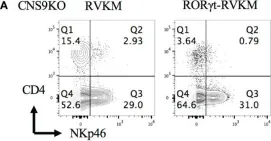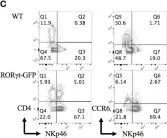Long-lived memory CD8+ T cells are essential for the control of persistent viral infections. The mechanisms that preserve memory cells are poorly understood. Fate mapping of the transcriptional repressor GFI1 identified that GFI1 was differentially regulated in virus-specific CD8+ T cells and was selectively expressed in stem cell memory and central memory cells. Deletion of GFI1 led to reduced proliferation and progressive loss of memory T cells, which in turn resulted in failure to maintain antigen-specific CD8+ T cell populations following infection with chronic lymphocytic choriomeningitis virus or murine cytomegalovirus. Ablation of GFI1 resulted in downregulation of the transcription factors EOMES and BCL-2 in memory CD8+ T cells. Ectopic expression of EOMES rescued the expression of BCL-2, but the persistence of memory CD8+ T cells was only partially rescued. These findings highlight the critical role of GFI1 in the long-term maintenance of memory CD8+ T cells in persistent infections by sustaining their proliferative potential.
© 2025. Crown.
Product Citations: 79
GFI1-driven transcriptional and epigenetic programs maintain CD8+ T cell stemness and persistence.
In Nature Immunology on 15 May 2025 by Chaudhry, M. Z., Chen, E., et al.
-
Biochemistry and Molecular biology
-
Genetics
-
Immunology and Microbiology
In The Journal of Clinical Investigation on 13 May 2025 by Chandra, S., Popović, J., et al.
Accumulating evidence implicates the gut microbiome (GMB) in the pathogenesis and progression of Alzheimer's disease (AD). We recently showed that the GMB regulates reactive astrocytosis and Aβ plaque accumulation in male APPPS1-21 AD model mice. Yet, the mechanism(s) by which GMB perturbation alters reactive astrocytosis in a manner that reduces Aβ deposition remain unknown. Here, we performed metabolomics on plasma from mice treated with antibiotics (abx) and identified a significant increase in plasma propionate, a gut-derived short chain fatty acid, only in male mice. Administration of sodium propionate reduced reactive astrocytosis and Aβ plaques in APPPS1-21 mice, phenocopying the abx-induced phenotype. Astrocyte-specific RNA sequencing on abx and propionate treated mice showed reduced expression of pro-inflammatory and increased expression of neurotrophic genes. Next, we performed flow cytometry experiments where we found abx and propionate decreased peripheral RAR-related orphan receptor-γ (Rorγt)+ CD4+ (Th17) cells and IL-17 secretion, which positively correlated with reactive astrocytosis. Lastly, using an IL-17 monoclonal antibody to deplete IL-17, we found that propionate reduces reactive astrocytosis and Aβ plaques in an IL-17-dependent manner. Together, these results suggest that gut-derived propionate regulates reactive astrocytosis and Aβ amyloidosis by decreasing peripheral Th17 cells and IL-17 release. Thus, propionate treatment or strategies boosting propionate production may represent novel therapeutic strategies for AD.
Altered hepatic metabolic landscape and insulin sensitivity in response to pulmonary tuberculosis.
In PLoS Pathogens on 1 September 2024 by Das, M. K., Savidge, B., et al.
Chronic inflammation triggers development of metabolic disease, and pulmonary tuberculosis (TB) generates chronic systemic inflammation. Whether TB induced-inflammation impacts metabolic organs and leads to metabolic disorder is ill defined. The liver is the master regulator of metabolism and to determine the impact of pulmonary TB on this organ we undertook an unbiased mRNA and protein analyses of the liver in mice with TB and reanalysed published data on human disease. Pulmonary TB led to upregulation of genes in the liver related to immune signalling and downregulation of genes encoding metabolic processes. In liver, IFN signalling pathway genes were upregulated and this was reflected in increased biochemical evidence of IFN signalling, including nuclear location of phosphorylated Stat-1 in hepatocytes. The liver also exhibited reduced expression of genes encoding the gluconeogenesis rate-limiting enzymes Pck1 and G6pc. Phosphorylation of CREB, a transcription factor controlling gluconeogenesis was drastically reduced in the livers of mice with pulmonary TB as was phosphorylation of other glucose metabolism-related kinases, including GSK3a, AMPK, and p42. In support of the upregulated IFN signalling being linked to the downregulated metabolic functions in the liver, we found suppression of gluconeogenic gene expression and reduced CREB phosphorylation in hepatocyte cell lines treated with interferons. The impact of reduced gluconeogenic gene expression in the liver was seen when infected mice were less able to convert pyruvate, a gluconeogenesis substrate, to the same extent as uninfected mice. Infected mice also showed evidence of reduced systemic and hepatic insulin sensitivity. Similarly, in humans with TB, we found that changes in a metabolite-based signature of insulin resistance correlates temporally with successful treatment of active TB and with progression to active TB following exposure. These data support the hypothesis that TB drives interferon-mediated alteration of hepatic metabolism resulting in reduced gluconeogenesis and drives systemic reduction of insulin sensitivity.
Copyright: © 2024 Das et al. This is an open access article distributed under the terms of the Creative Commons Attribution License, which permits unrestricted use, distribution, and reproduction in any medium, provided the original author and source are credited.
-
Biochemistry and Molecular biology
-
Cardiovascular biology
-
Cell Biology
-
Endocrinology and Physiology
-
Immunology and Microbiology
Preprint on BioRxiv : the Preprint Server for Biology on 22 June 2024 by Chen, Z., Ford, K. P., et al.
Patients aged 65 years and older account for an increasing proportion of patients with traumatic brain injury (TBI). Older TBI patients experience increased morbidity and mortality compared to their younger counterparts. Our prior data demonstrated that by blocking α4 integrin, anti-CD49d antibody (aCD49d Ab) abrogates CD8+ T-cell infiltration into the injured brain, improves survival, and attenuates neurocognitive deficits. Here, we aimed to uncover how aCD49d Ab treatment alters local cellular responses in the aged mouse brain. Consequently, mice incur age-associated toxic cytokine and chemokine responses long-term post-TBI. aCD49d Ab attenuates this response along with a T helper (Th)1/Th17 immunological shift and remediation of overall CD8+ T cell cytotoxicity. Furthermore, aCD49d Ab reduces CD8+ T cells exhibiting higher effector status, leading to reduced clonal expansion in aged, but not young, mouse brains with chronic TBI. Together, aCD49d Ab is a promising therapeutic strategy for treating TBI in the older people. Graphic abstract Aged brains after TBI comprise two pools of CD8 + T cells . The aged brain has long been resided by a population of CD8 + T cells that’s exhaustive and dysfunctional. Post TBI, due to BBB impairment, functional CD8 + T cells primarily migrate into the brain parenchyma. Aged, injury-associated microglia with upregulated MHC class I molecules can present neoantigens such as neuronal and/or myelin debris in the injured brains to functional CD8+ T, resulting in downstream CD8+ T cell cytotoxicity. aCD49d Ab treatment exerts its function by blocking the migration of functional effector CD8 + T cell population, leading to less cytotoxicity and resulting in improved TBI outcomes in aged mice.
-
Mus musculus (House mouse)
-
Immunology and Microbiology
In Aging Cell on 1 June 2024 by Fisher, J. S., Adán-Barrientos, I., et al.
Weakened germinal center responses by the aged immune system result in diminished immunity against pathogens and reduced efficacy of vaccines. Prolonged contacts between activated B cells and CD4+ T cells are crucial to germinal center formation and T follicular helper cell (Tfh) differentiation, but it is unclear how aging impacts the quality of this interaction. Peptide immunization confirmed that aged mice have decreased expansion of antigen-specific germinal center B cells and reduced antibody titers. Furthermore, aging was associated with accumulated Tfh cells, even in naïve mice. Despite increased numbers, aged Tfh had reduced expression of master transcription factor BCL6 and increased expression of the ectonucleotidase CD39. In vitro activation revealed that proliferative capacity was maintained in aged CD4+ T cells, but not the costimulatory molecule CD40L. When activated in vitro by aged antigen-presenting cells, young CD4+ naïve T cells generated reduced numbers of activated cells with upregulated CD40L. To determine the contribution of cell-extrinsic influences on antigen-specific Tfh induction, young, antigen-specific B and CD4+ T cells were adoptively transferred into aged hosts prior to peptide immunization. Transferred cells had reduced expansion and differentiation into germinal center B cell and Tfh and reduced antigen-specific antibody titers when compared to young hosts. Young CD4+ T cells transferred aged hosts differentiated into Tfh cells with reduced PD-1 and BCL6 expression, and increased CD39 expression, though they maintained their mitochondrial capacity. These results highlight the role of the lymphoid microenvironment in modulating CD4+ T cell differentiation, which contributes to impaired establishment and maintenance of germinal centers.
© 2024 The Authors. Aging Cell published by Anatomical Society and John Wiley & Sons Ltd.
-
Mus musculus (House mouse)
-
Cell Biology
-
Immunology and Microbiology
In Front Immunol on 28 March 2023 by Chang, D., Zhang, H., et al.
Fig.6.A

-
FC/FACS
-
Mus musculus (House mouse)
Collected and cropped from Front Immunol by CiteAb, provided under a CC-BY license
Image 1 of 3
In Front Immunol on 28 March 2023 by Chang, D., Zhang, H., et al.
Fig.1.B

-
FC/FACS
-
Mus musculus (House mouse)
Collected and cropped from Front Immunol by CiteAb, provided under a CC-BY license
Image 1 of 3
In Front Immunol on 28 March 2023 by Chang, D., Zhang, H., et al.
Fig.5.C

-
FC/FACS
-
Mus musculus (House mouse)
Collected and cropped from Front Immunol by CiteAb, provided under a CC-BY license
Image 1 of 3


